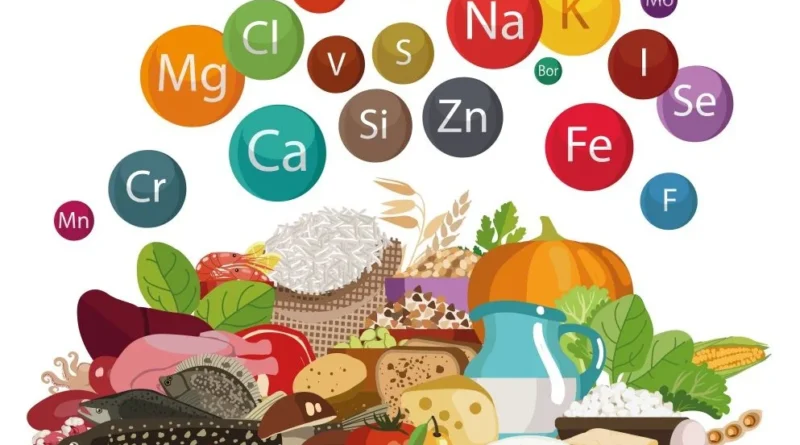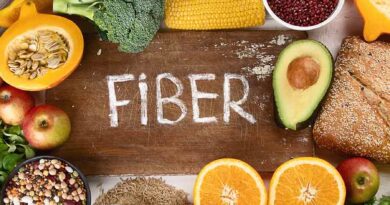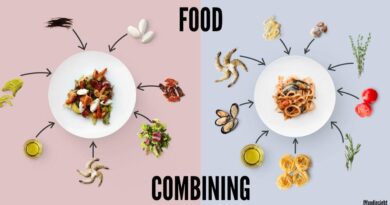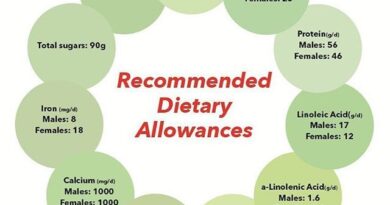Minerals
Minerals are defined as those elements which largely remain as ash when plant or animal tissues are completely burnt. In the context of nutrition, a mineral is a inorganic chemical element required as an essential nutrient by organisms to perform functions necessary for life. The body uses minerals for many different jobs, including keeping bones, muscles, heart, and brain working properly. Minerals are also important for making enzymes and hormones. Most people get the amount of minerals they need by eating a wide variety of foods. In some cases, your doctor may recommend a mineral supplement. People who have certain health problems or take some medicines may need to get less of one of the minerals. For example, people with chronic kidney disease need to limit foods that are high in potassium.
What are different types of minerals ?
There are total 19 types of minerals present in the human body which forms 4-6% of total body weight. Minerals can be divided into two categories based to quantity required :-
- Macrominerals (Required in large amounts :- Calcium, Phosphorus, Sodium, Potassium, Chloride and magnesium are part of this category.
- Trace minerals (Required in small amounts) :- Iron, Iodine, Zinc and Copper are part of this category.
Calcium and Phosphorus
Together these two minerals account for 75% of total mineral content of the body. Human body contains approximately 1200gm of calcium, most of which (approx 99%) is present in bones and teeth and remaining in soft tissues and in the body fluids. On the other hand, only 400-700gm of phosphorus is contained in the body. And same as Calcium it is present in teeth and bones and rest in soft tissues and body fluids.
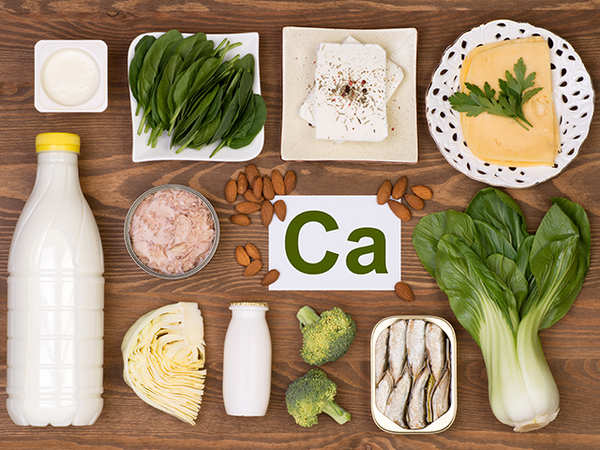
What are functions/Benefits of Calcium and Phosphorus ?
- Development of bones and teeth :- Ratio of calcium and phosphorus in the bones is roughly 2:1. Calcium in the bone combines with phosphorus, some other minerals and water to form a compound. This compound provides rigidity and firmness to bones.
- Regulation of body processes :-
- Calcium helps in –
- Regulating the contraction and relaxation of muscles especially that of the heart
- Regulating the passage of substance into and out of the cell
- Conveying messages from one nerve cell to another
- The clotting of blood
- Phosphorus is required for –
- Formation of a substance which aids in transport of fat in blood
- Synthesis of certain coenzymes which play a crucial role in metabolism
- Formation of certain basic genetic material which is involved in passing on of specific characteristics from parents to children
- Capture and storage of vital energy in the cells of many tissues by forming a high-energy compound. Muscle tissue is a prominent example where phosphorus helps in energy storage and thus fuels muscle contraction

How much Calcium and Phosphorus is required by body ?
The exact amount of calcium you need depends on your age and other factors. Growing children and teenagers need more calcium than young adults. Older women need plenty of calcium to prevent osteoporosis. People who do not eat enough high-calcium foods should take a calcium supplement.
What are sources of Calcium and Phosphorus ?
- Milk and milk products like curd, khoa, channa (cottage cheese) are excellent sources of calcium. Foods like fish (e.g. chingri, chela) especially dried fish and other sea foods (e.g. crab, shrimp) provide substantial quantities of calcium.
- Among the plant sources ragi is particularly rich in calcium. Pulses like bengal gram, black gram, green gram, moth beans, rajmah, soya bean, contribute substantial amounts of calcium. Green leafy vegetables, gingelly (til) seed is particularly rich in calcium.
- Eggs, milk, poultry, fish are excellent sources of phosphorus. Cereals are too rich sources of the minerals.
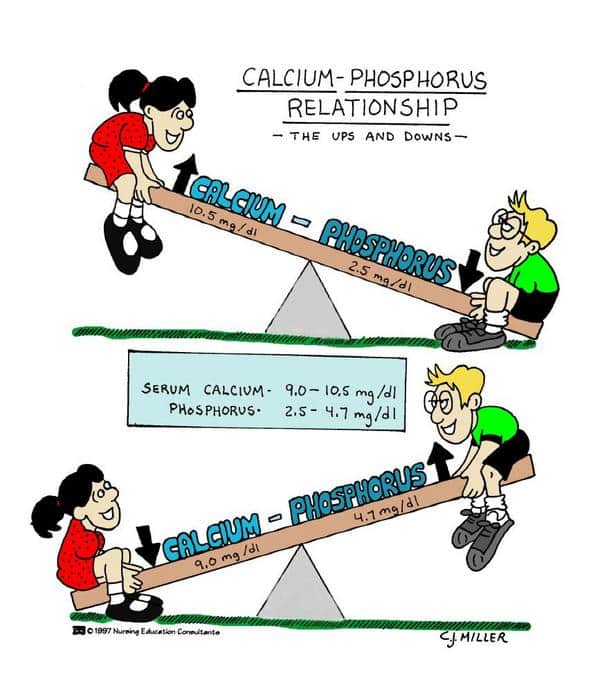
How Calcium and Phosphorus are absorbed and utilised by body ?
Calcium is absorbed chiefly from the upper part of the intestine. Normally it is seen that from an average indian diet only 20-30 percent of calcium gets absorbed. The rest is excreted in the feces. The reason for this is given below :-
- Body Need :- When the body’s demand increases (during pregnancy and lactation), the absorption of calcium also increases to meet this demand.
- Nutrients in the diet :- Nutrients like vitamin D, protein and carbohydrates present in the diet help to improve absorption of calcium. The proportion of calcium and phosphorus in the diet affects calcium absorption. Excess phosphorus tend to lower calcium absorption.
- Inhibitors :- These are substances present in food which hinder calcium absorption. All calcium present in cereals and green leafy vegetables are not available to the body because some substances (such as phytates in cereals and oxalates in green leafy vegetables) are present in them which bind calcium and inhibit its absorption
Absorption of phosphorus also takes place from the upper part of the small intestine. However, a considerable amount of phosphorus in cereals, pulses and nuts exists in a bound form which is not absorbed. The body takes in only the free form.
Sodium
Sodium is a chemical element with the symbol Na (from Latin natrium) and atomic number 11. It is a soft, silvery-white, highly reactive metal. Sodium is an alkali metal, being in group 1 of the periodic table. Its only stable isotope is 23Na. The free metal does not occur in nature, and must be prepared from compounds. Sodium is the sixth most abundant element in the Earth’s crust and exists in numerous minerals such as feldspars, sodalite, and rock salt (NaCl). An adult body contains approximately 120 gm of Sodium. Most of this is present in the extracellular fluid. Sodium is ingested and readily absorbed by the digestive tract and used for various body functions. The excess sodium is lost through urine, sweat and feces.
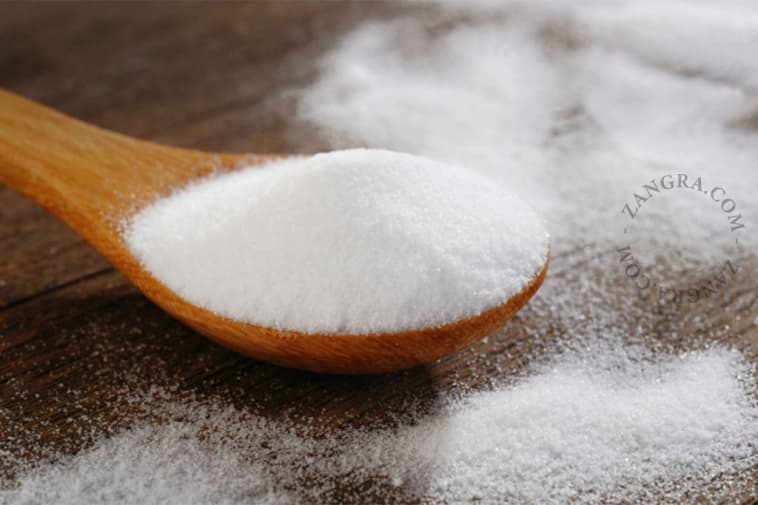
What are functions of Sodium ?
- Regulating the balance of extracellular and intercellular fluid.
- Regulating the alkalinity and acidity of the body fluids :- Sodium tend to make the body fluids alkaline. Another minerals namely chloride present in the body fluids tend to make them acidic. So, sodium combines with chloride in the fluid and together they help maintain balance.
- Aiding in the passage of messages from one nerve cell to another.
- Aiding the contraction of muscles and
- Regulating the passage of substances into and out of the cell.
What are the food sources of Sodium ?
Common table salt is the principal source of sodium in our diet. One teaspoon of salt provides almost 2000mg sodium. Other rich sources of Sodium include milk, egg white, vegetables such as spinach, fenugreek leaves and pulses among the plant sources.
Potassium
Potassium is a chemical element with the symbol K (from Neo-Latin kalium) and atomic number 19. Potassium is a silvery-white metal that is soft enough to be cut with a knife with little force. Potassium in nature occurs only in ionic salts. Potassium ions are vital for the functioning of all living cells. The transfer of potassium ions across nerve cell membranes is necessary for normal nerve transmission; potassium deficiency and excess can each result in numerous signs and symptoms, including an abnormal heart rhythm and various electrocardiographic abnormalities. Potassium is present in twice as much amount as sodium in the body. Approx. 250gm of Potassium is contained in the body and most of this is present in the cells i.e in the intracellular fluid. Potassium gets absorbed from the upper part of the intestine. Excess potassium is excreted in the urine and the feces.
What are functions of Potassium in human body ?
- Regulation of the balance of intracellular and extracellular fluid.
- Regulation of the alkalinity/acidity of body fluids.
- Potassium has a significant role in the activity of skeletal and heart muscle. It helps in the transmission of messages which results in the contraction of muscle tissue.
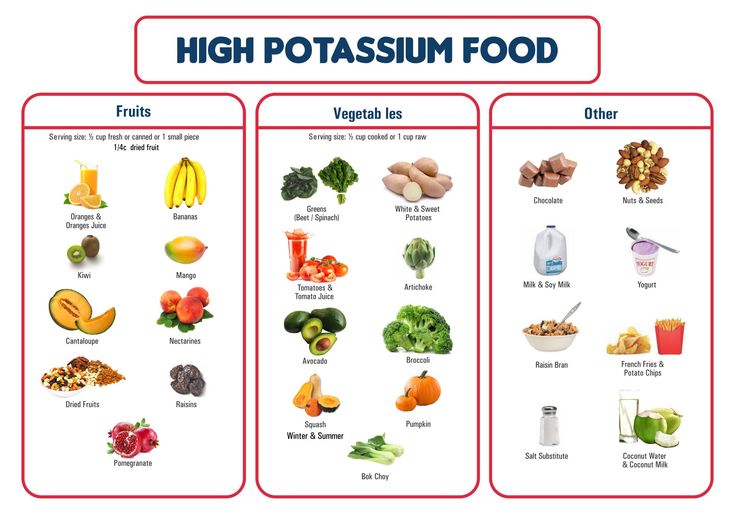
What are food sources of Potassium ?
Meat, poultry and fish are good sources. Among the plant foods, pulses, fruits, vegetables especially the green leafy vegetables are good sources of potassium. The water of the tender coconut is the best source of potassium.
Chloride
The chloride ion is the anion (negatively charged ion) Cl−. It is formed when the element chlorine (a halogen) gains an electron or when a compound such as hydrogen chloride is dissolved in water or other polar solvents. Chloride salts such as sodium chloride are often very soluble in water. It is an essential electrolyte located in all body fluids responsible for maintaining acid/base balance, transmitting nerve impulses and regulating liquid flow in and out of cells. The body contains approximately 100gm of Chloride and most of this is found in extracellular fluid (especially in the blood plasma). The rest of the chloride is present inside the cell. Chloride is present in the extracellular fluid as sodium chloride and in the cell as potassium chloride. Chloride is readily absorbed from the upper part of the intestine. Excess chloride is excreted in the urine and to a lesser extent through the sweat and the feces.
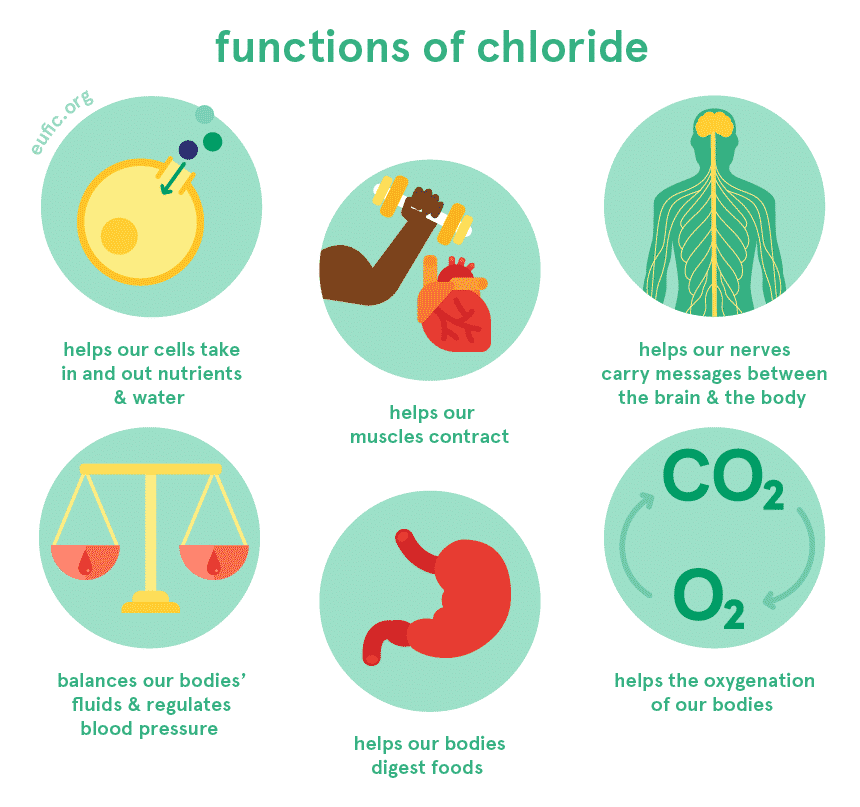
What are food sources of Chloride ?
Chloride is widely distributed in all plant foods. But the most important source of chloride in our diet is common table salt i.e. Sodium Chloride.
Magnesium
Magnesium is a chemical element with the symbol Mg and atomic number 12. It is a shiny gray solid which shares many physical and chemical properties with the other five alkaline earth metals. This element is the eleventh most abundant element by mass in the human body and is essential to all cells and some 300 enzymes. The adult human body contains approximately 20-25gm of magnesium. About 60-70% of this magnesium is present in the bones in combination with calcium and phosphorus. The remaining 30-40 percent is distributed in various tissues and body fluids mostly in the intracellular fluid. Magnesium compounds are used medicinally as common laxatives, antacids (e.g., milk of magnesia), and to stabilize abnormal nerve excitation or blood vessel spasm in such conditions as eclampsia. Magnesium is absorbed from the small intestine. When the body’s demand increases, the absorption increases so as to meet the increased demand. The excretion of magnesium by the body is regulated by the kidneys.
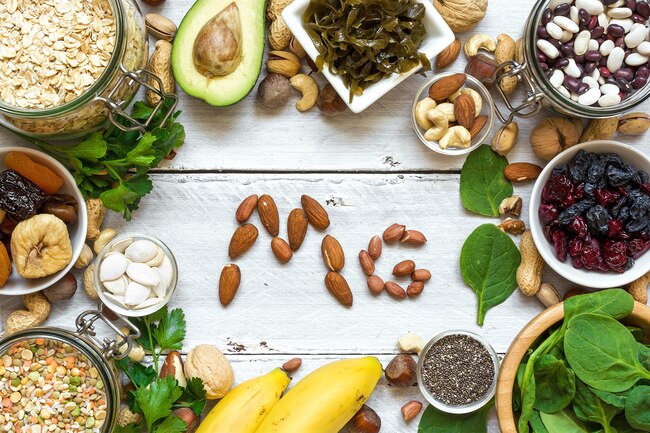
What are functions of Magnesium ?
Magnesium helps in :-
- Regulating the passage of substances into and out of the cells.
- Maintaining the activity of many enzymes. Magnesium functions as a coenzyme in metabolism.
- Building bones and teeth.
- Maintaining the functions of the nervous system.
- Maintaining smooth muscle action
- Building proteins
What are food sources of Magnesium ?
Nuts (groundnut, cashewnut, walnut, almond), oilseeds (sesame seeds), pulses (rajmah, moth beans, soyabean), whole grains (wheat, bajra, jowar), sea food, meat etc.
Iron
Iron is a chemical element with symbol Fe (from Latin: ferrum) and atomic number 26. It is, by mass, the most common element on Earth, right in front of oxygen (32.1% and 30.1%, respectively), forming much of Earth’s outer and inner core. It is the fourth most common element in the Earth’s crust. The body of an adult human contains about 4 grams (0.005% body weight) of iron, mostly in hemoglobin and myoglobin. These two proteins play essential roles in vertebrate metabolism, respectively oxygen transport by blood and oxygen storage in muscles. To maintain the necessary levels, human iron metabolism requires a minimum of iron in the diet. Iron is also the metal at the active site of many important redox enzymes dealing with cellular respiration and oxidation and reduction in plants and animals. Most of it is found in blood (approx 75%). Other 5% is in cells & tissues (mainly muscle tissues) and rest 20% is stored in the body organs such as liver, spleen, kidney and bone marrow.
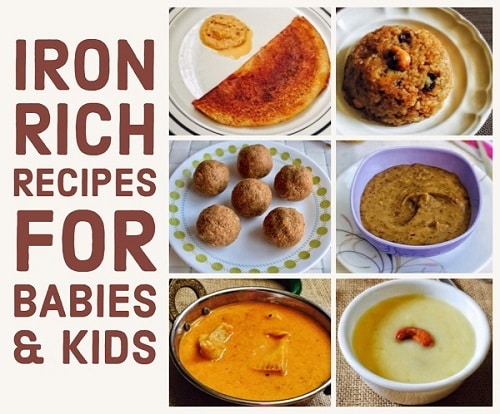
What are functions of Iron ?
- Oxygen Transport :- Iron is major constituent of haemoglobin which is necessary for transport of oxygen to various parts of the body.
- Provision of oxygen for muscle contraction :- Iron is also present in the muscle in the form of myoglobin. Myoglobin has the capacity to store oxygen which is used for muscle contraction and for other immediate needs of the muscle cells.
- Promotion of oxidation within cells :- It facilitates the complete oxidation of carbohydrates, fats and protein within the cell. Iron is crucial in helping us to perform physical work.
- Iron plays important role in maintenance of specific brain functions like immediate memory, capacity to learn and attention span.
- Iron forms a vital component of certain enzymes and substances that aid in metabolism.
- Iron has protective functions, it helps in preventing infections.
What are food sources of Iron ?
Liver is an excellent source. Other organ meats like kidney, spleen also contain substantial amounts of iron. Plant foods like green leafy vegetables, cereals, pulses also contain iron. Jaggery is another food that contains fair amounts of iron.
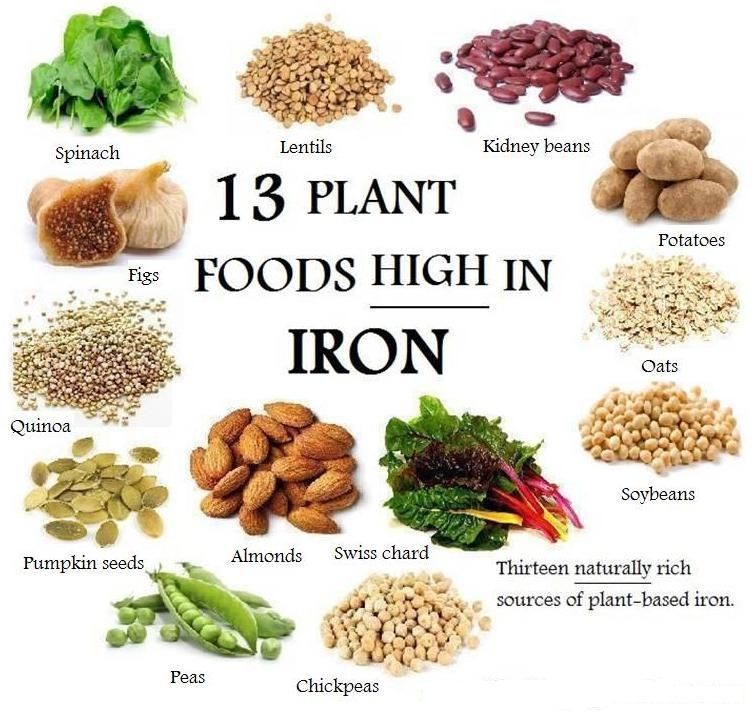
How Iron is absorbed and excreted by the body ?
The ingested iron gets absorbed from the upper part of the intestine. The absorption from animal foods is high. But the amounts of iron absorbed from many plant sources is very low because of the presence of inhibitors which bind iron and hinder its absorption. These are substances like protein and vitamin C that aid in the absorption of iron and called enhancers. So protein rich food should be included in the diet to promote the absorption of iron.
Iodine
Iodine is a chemical element with the symbol I and atomic number 53. The heaviest of the stable halogens, it exists as a semi-lustrous, non-metallic solid at standard conditions that melts to form a deep violet liquid at 114 degrees Celsius, and boils to a violet gas at 184 degrees Celsius. It is the heaviest essential mineral nutrient. Iodine is essential in the synthesis of thyroid hormones. Iodine deficiency affects about two billion people and is the leading preventable cause of intellectual disabilities. The adult body contains a very small amount of iodine which amounts to only 20-25mg. The maximum concentration is found in thyroid gland which is located in neck region. It is absorbed in the small intestine in the form of iodides (components of iodine). These are carried by blood to the thyroid gland. About 1/3rd of iodine is picked up by the thyroid gland and rest is excreted.
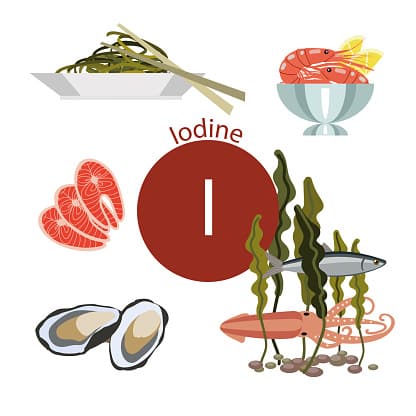
What are functions of Iodine ?
Iodine is a component of hormone thyroxine secreted by the thyroid gland. Thyroxine regulates the rate of oxidation within the cells absence of which will affect both physical and mental growth.
What are food sources of Iodine ?
Sea foods like fish, shell fish are among best sources of iodine. It is important to ensure that iodised salt forms a part of the daily diet because its abundance is low.
Zinc
Zinc is a trace mineral, meaning that the body only needs small amounts, and yet it is necessary for almost 100 enzymes to carry out vital chemical reactions. It is a major player in the creation of DNA, growth of cells, building proteins, healing damaged tissue, and supporting a healthy immune system. [1] Because it helps cells to grow and multiply, adequate zinc is required during times of rapid growth, such as childhood, adolescence, and pregnancy. Zinc is also involved with the senses of taste and smell. The Recommended Dietary Allowance (RDA) for adults 19+ years is 11 mg a day for men and 8 mg for women. Pregnancy and lactation requires slightly more at 11 mg and 12 mg, respectively.
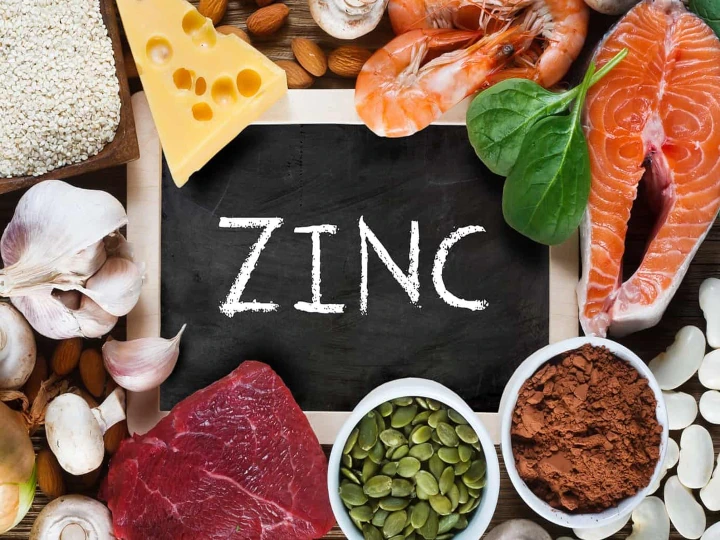
What are food sources of Zinc ?
Meats, poultry, and seafood are rich in zinc. Some plant foods like legumes and whole grains are also good sources of zinc, but they also contain phytates that can bind to the mineral, lowering its absorption.
- Shellfish: oysters, crab, lobster
- Beef
- Poultry
- Pork
- Legumes
- Nuts, seeds
- Whole grains
- Fortified breakfast cereals
Copper
Copper is a chemical element with the symbol Cu (from Latin: cuprum) and atomic number 29. It is a soft, malleable, and ductile metal with very high thermal and electrical conductivity. A freshly exposed surface of pure copper has a pinkish-orange color.Copper helps in haemoglobin synthesis and is essential constituent of certain enzymes. Copper is essential to all living organisms as a trace dietary mineral because it is a key constituent of the respiratory enzyme complex cytochrome c oxidase. In molluscs and crustaceans, copper is a constituent of the blood pigment hemocyanin, replaced by the iron-complexed hemoglobin in fish and other vertebrates. In humans, copper is found mainly in the liver, muscle, and bone. The adult body contains between 1.4 and 2.1 mg of copper per kilogram of body weight.
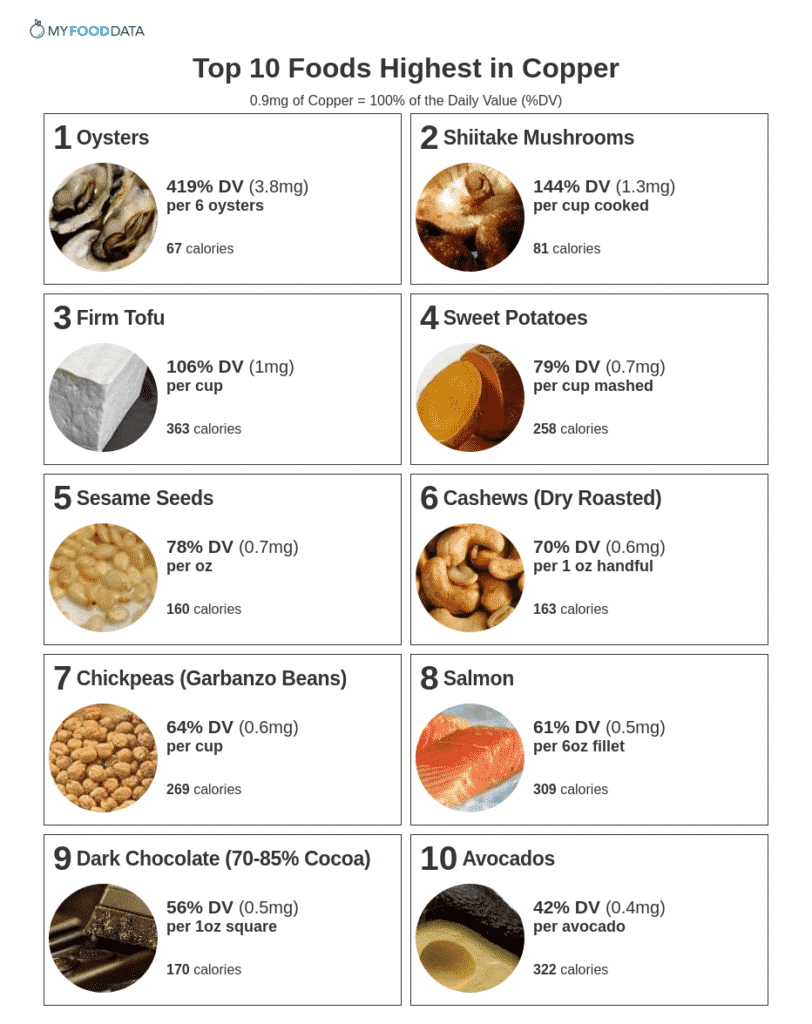
What are food sources of Copper ?
Oysters and other shellfish, whole grains, beans, nuts, potatoes, and organ meats (kidneys, liver) are good sources of copper. Dark leafy greens, dried fruits such as prunes, cocoa, black pepper, and yeast are also sources of copper in the diet.

